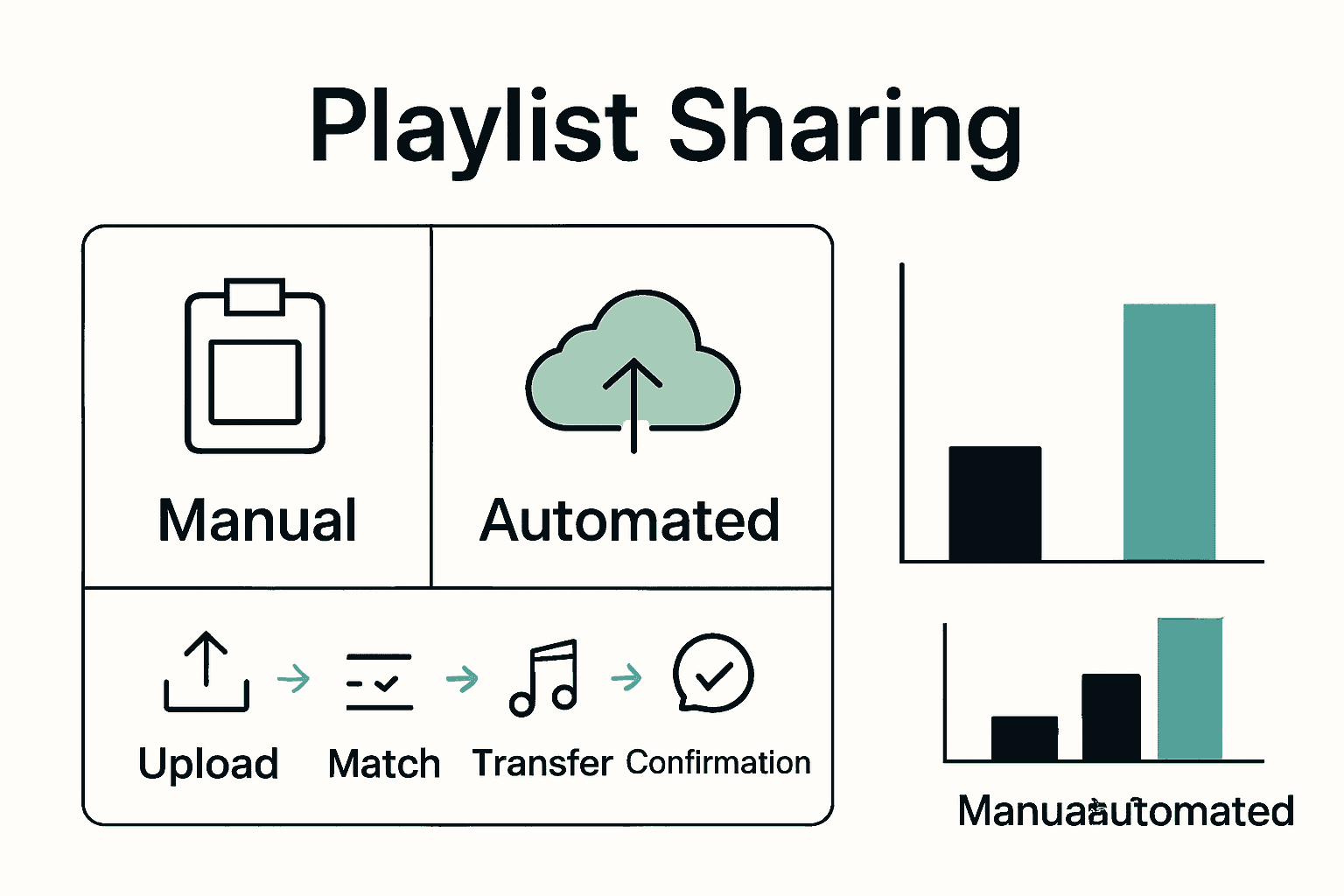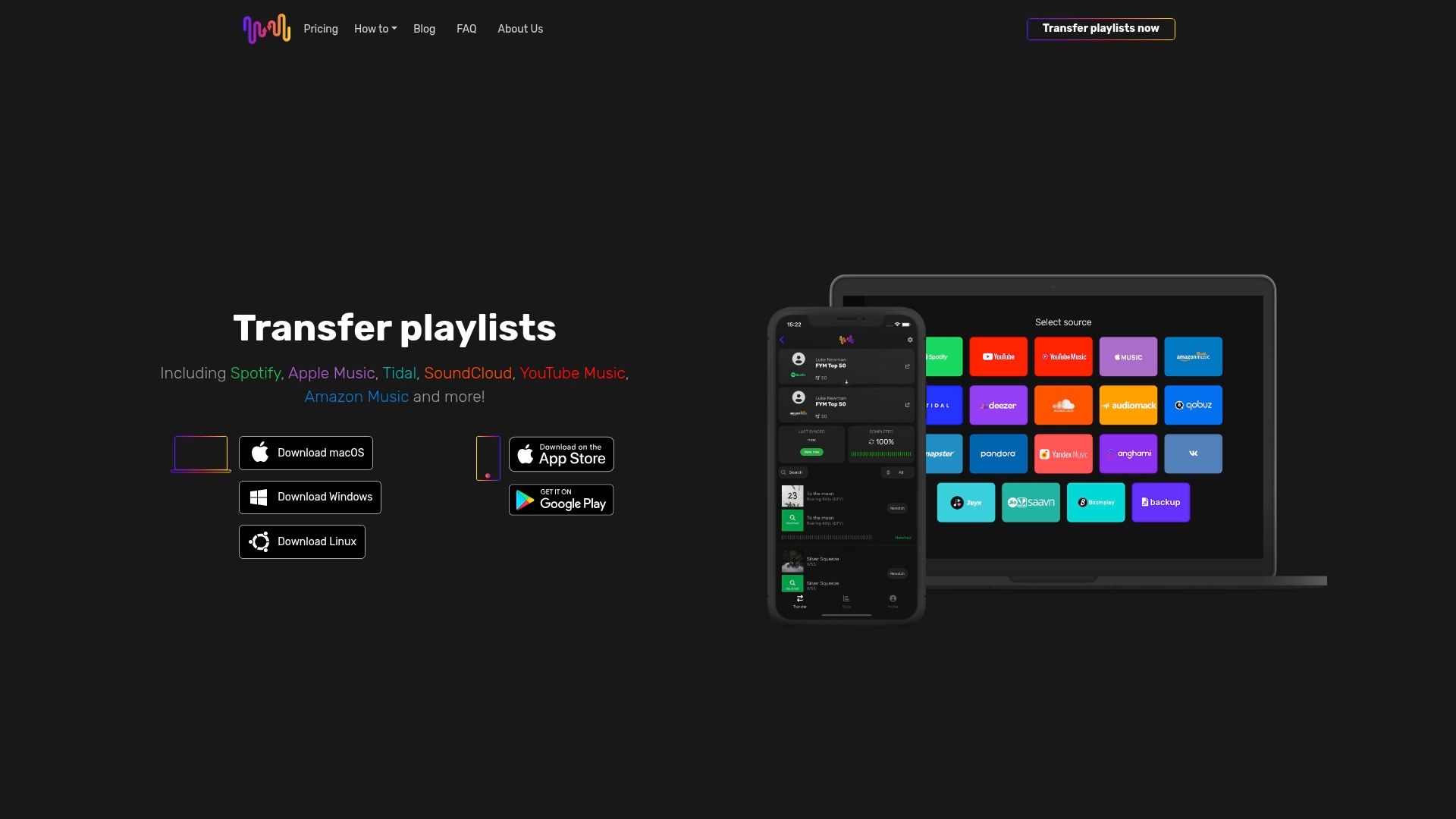Most people think sharing a playlist means just sending a link, but over 60% of users are surprised by how complex true playlist sharing can be. With streaming services everywhere, sharing your music isn't as simple as it seems. From song compatibility to preserving track order, there are hidden hurdles that catch even savvy listeners off guard. Get a clear look at what playlist sharing really involves, the common myths, and how you can master this powerful tool for music connection.
Table of Contents
- Defining Playlist Sharing And Common Misconceptions
- Major Types Of Playlist Sharing Methods
- How Playlist Sharing Works Across Services
- Benefits For Users, Groups, And Professionals
- Security, Privacy, And Legal Considerations
- Comparing Playlist Sharing Alternatives
Key Takeaways
| Point | Details |
|---|---|
| Playlist Sharing Complexity | True playlist sharing involves maintaining metadata and compatibility, not just sending a link. |
| Evolving Sharing Methods | Users can share playlists through direct links, cross-platform transfers, or manual recreation, each with its pros and cons. |
| Cultural and Professional Value | Playlist sharing serves as a cultural intermediary and is essential for professionals in music, enhancing communication and discovery. |
| Security and Legal Awareness | Users must navigate privacy, security, and legal considerations when sharing playlists to protect their personal data and digital rights. |
Defining Playlist Sharing and Common Misconceptions
Playlist sharing is a digital music exchange method that allows users to transfer, distribute, and collaborate on music collections across various platforms and devices. According to the XML Shareable Playlist Format, this practice involves creating portable digital media playlists that can be interchangeably used across different music streaming services.
Contrary to popular belief, playlist sharing isn't just about sending a link. Playlist sharing involves complex processes of transferring entire music collections, maintaining playlist structures, and ensuring song compatibility across different streaming platforms. Many users mistakenly think sharing means simply sending a public link, but true sharing requires maintaining playlist integrity, metadata, and song order.
The cultural significance of playlist sharing extends beyond mere music exchange. As research from Culture Unbound suggests, algorithmically generated playlists function as cultural intermediaries that reshape artist-fan relationships. This means playlist sharing isn't just a technical process, but a form of musical communication and discovery.
Common misconceptions about playlist sharing include:
- Believing all platforms support direct playlist transfers
- Assuming song availability is universal across services
- Thinking playlist sharing is a simple copy-paste process
Understanding these nuances helps users approach playlist sharing more strategically, recognizing it as a sophisticated method of musical expression and connection. For more insights into effective music sharing techniques, check out our smart music sharing methods guide.
Major Types of Playlist Sharing Methods
Playlist sharing methods have evolved dramatically with digital technology, offering users multiple ways to exchange and distribute music collections. According to the Open Music Model, these methods emphasize open file sharing and flexible distribution approaches that support user connectivity and music discovery.
The primary types of playlist sharing methods include:
- Direct Platform Sharing
- Sending playlist links within native streaming platforms
- Collaborative playlist creation
- Public playlist publishing
- Cross-Platform Transfers
- Migrating entire playlists between different streaming services
- Preserving metadata and song ordering
- Ensuring maximum song compatibility
- Manual Sharing Methods
- Screenshotting and recreating playlists
- Copying and manually rebuilding track lists
- Exporting playlist data as shareable files
As the XML Shareable Playlist Format demonstrates, technical standards now support interoperable playlist exchanges across diverse digital platforms. This means users can transfer music collections with increasing ease and precision.
Understanding these sharing methods helps music enthusiasts maximize their listening experience and connect with other music lovers. For a comprehensive guide on sharing playlists effectively, explore our complete playlist sharing user guide.
How Playlist Sharing Works Across Services
Playlist sharing across different music streaming services involves complex technical processes that enable seamless music collection transfers. According to Recommender Systems, these platforms utilize advanced algorithms that analyze user preferences and behavior to facilitate more intelligent and personalized music sharing experiences.
Crossplatform Compatibility Challenges include:
- Metadata matching between different streaming services
- Song availability variations across platforms
- Unique identifier tracking for individual tracks
- Preserving original playlist sequence and organization
The Open Music Model highlights the importance of creating flexible, open systems that support music distribution across multiple services. This approach enables users to transfer playlists with minimal friction, breaking down traditional platform barriers.

Most modern music streaming services now incorporate intelligent transfer mechanisms that automatically:
- Detect song matches across platforms
- Replace unavailable tracks with similar alternatives
- Maintain playlist integrity during transfers
- Provide users with transparent transfer reports
Unique technical approaches like metadata mapping and algorithmic song matching have transformed playlist sharing from a manual, time-consuming process to a nearly instantaneous digital experience. For specific strategies on sharing playlists effectively, check out our tutorial on Spotify playlist sharing.
Benefits for Users, Groups, and Professionals
Playlist sharing offers transformative advantages across various user segments, creating new opportunities for music discovery and collaboration. According to research from Culture Unbound, algorithmically generated playlists serve as powerful cultural intermediaries that reshape how individuals connect through music, extending beyond simple track collections.
Benefits for Individual Users:
- Seamless music library migration between platforms
- Discovering new artists through shared playlists
- Preserving personal music collections during service transitions
- Creating personalized musical narratives
Group and Collaborative Advantages:
- Enabling shared musical experiences
- Facilitating group playlist curation
- Creating community through music selection
- Supporting remote social connections through music
For professionals like DJs, music curators, and educators, playlist sharing becomes an essential tool for communication and research. As demonstrated by Link.springer, playlists can serve as sophisticated research and educational instruments, allowing nuanced exploration of cultural and learning spaces.
Professional Use Cases:
- Creating educational and research playlists
- Developing professional music portfolios
- Sharing industry trends and discoveries
- Supporting music marketing and promotion strategies
These multifaceted benefits illustrate how playlist sharing has evolved from a simple file transfer to a rich, collaborative communication medium.
For insights into maximizing your playlist sharing experience, explore our collaborative playlist tutorial.
Security, Privacy, and Legal Considerations
Playlist sharing introduces complex legal and privacy considerations that users must carefully navigate. According to the Open Music Model, digital music distribution requires a thoughtful approach to addressing digital rights management and potential piracy concerns.
Key Privacy Considerations:
- Personal music preference protection
- Control over shared playlist visibility
- Data encryption during transfers
- Limiting third-party data access
- Maintaining user anonymity
Security Risks in Playlist Sharing:
- Potential unauthorized playlist access
- Metadata exposure
- Personal profile information leakage
- Algorithmic tracking of music preferences
- Potential misuse of shared playlist data
As Data Publishing research highlights, releasing digital information involves intricate legal implications that extend beyond simple data transfer. Users must understand their rights and potential vulnerabilities when sharing music collections across digital platforms.
Legal Protection Strategies:
- Reading platform-specific terms of service
- Understanding copyright implications
- Using privacy-focused sharing tools
- Limiting personal information exposure
- Regularly reviewing shared content permissions
Ensuring comprehensive security requires active user engagement and strategic approach to digital music sharing. For additional insights into protecting your musical collections, explore our playlist sharing best practices guide.
Comparing Playlist Sharing Alternatives
Playlist sharing technologies have evolved dramatically, offering multiple approaches for music collection transfer and discovery. According to Recommender Systems, different filtering techniques enable sophisticated methods of playlist sharing that go beyond traditional manual transfers.
Manual Sharing Methods:
- Screenshot and recreate playlists
- Copy-paste track lists
- Manually add songs across platforms
- Time-consuming and error-prone approach
Automated Sharing Approaches:
- Direct platform link sharing
- One-click playlist migration tools
- Algorithmic song matching
- Metadata preservation techniques
The Open Music Model emphasizes creating flexible distribution frameworks that support seamless music sharing across different platforms. This approach highlights the importance of developing interoperable systems that transcend individual streaming service limitations.
Advanced Sharing Technologies:
- Cross-platform synchronization
- Machine learning-powered transfer algorithms
- Intelligent song replacement strategies
- Comprehensive metadata tracking
- Privacy-protected transfer mechanisms
Navigating these alternatives requires understanding the strengths and limitations of each approach. Users seeking efficient playlist management should consider their specific needs and technical comfort level.
 For a comprehensive exploration of playlist transfer strategies, explore our guide to understanding playlist transfer challenges.
For a comprehensive exploration of playlist transfer strategies, explore our guide to understanding playlist transfer challenges.
Simplify Your Playlist Sharing and Unlock True Music Freedom
Sharing playlists across multiple streaming platforms can be confusing and frustrating. You want to keep your playlists intact with original song order and metadata, migrate your entire music collection without losses, and collaborate seamlessly without worrying about platform limitations. The challenges of cross-platform transfers, metadata matching, and unavailable tracks often lead to wasted time and disappointment. This is where understanding effective playlist sharing methods becomes essential.

Discover how FreeYourMusic.com removes these hurdles by offering an intuitive, reliable solution tailored to your needs. Whether you want to transfer playlists between Spotify, Apple Music, Tidal, or more, our platform preserves playlist structure, matches songs accurately, and supports unlimited transfers with multi-account access. Don’t let switching music services hold you back or force you into tedious manual playlist rebuilding. Start now and experience effortless music migration and smart playlist management by visiting FreeYourMusic.com today.
For in-depth guidance on making the most of your playlist sharing, explore our complete playlist sharing user guide and learn how to share Spotify playlists effectively.
Frequently Asked Questions
What is playlist sharing?
Playlist sharing is the digital exchange of music collections that allows users to transfer, distribute, and collaborate on playlists across various platforms and devices, maintaining the integrity and metadata of the playlists.
What are the main types of playlist sharing methods?
The primary types of playlist sharing methods include direct platform sharing (sending links), cross-platform transfers (migrating playlists between services), and manual sharing (screenshotting or recreating playlists).
What challenges are involved in sharing playlists between different music services?
Challenges include matching metadata between platforms, variations in song availability, tracking unique identifiers for tracks, and preserving the original playlist sequence during transfers.
How can users ensure security and privacy when sharing playlists?
Users can protect their privacy by controlling playlist visibility, using encryption during transfers, limiting third-party access, and understanding the terms of service for music streaming platforms.




